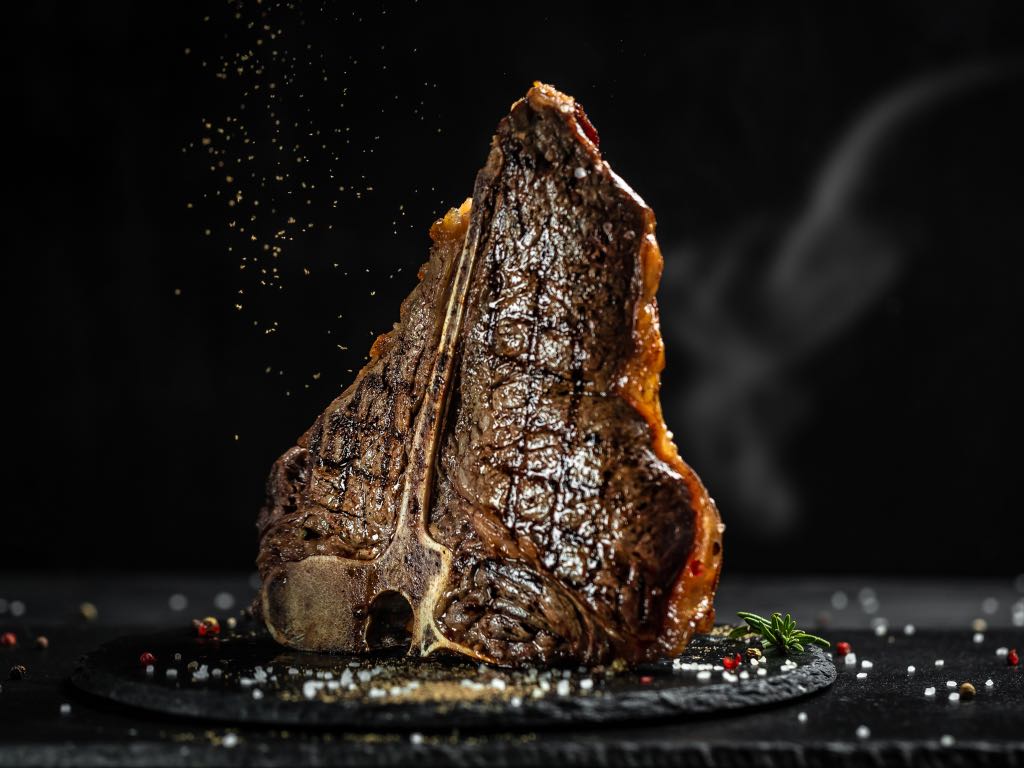
Porterhouse vs. T-Bone: Unraveling the Steak Showdown
|
|
Time to read 3 min
Welcome to One Stop Halal!
Written by: Yahya Lala
|
|
Time to read 3 min
When indulging in a mouthwatering steak, few cuts rival the satisfaction of sinking your teeth into a juicy, perfectly cooked Porterhouse or T-Bone steak. These two iconic cuts of beef offer a delightful combination of tender filet mignon and flavorful strip steak, making them favorites among meat connoisseurs. In this blog post, we'll delve into the battle of Porterhouse vs. T-Bone, exploring their similarities and differences and helping you decide which best suits your carnivorous cravings.
A Porterhouse steak is a large, thick-cut steak that combines two different cuts of beef: the tender filet mignon and the robust New York strip. It is typically sourced from the rear end of the short loin, closer to the sirloin section. To be considered a true Porterhouse, the filet mignon portion must be at least 1.25 inches wide at its widest point. The generous size of a Porterhouse makes it a showstopper on the plate and a popular choice for sharing. This comprehensive blog post will explore the battle of Porterhouse vs. T-bone steaks.
Similar to the Porterhouse, a T-Bone steak combines the filet mignon and the New York strip. The critical difference lies in the size of the filet mignon portion. To be classified as a T-Bone steak, the filet mignon must be less than 1.25 inches wide at its widest point. T-Bone steaks are typically cut from the front end of the short loin, closer to the rib section. They are known for their T-shaped bone, which gives them their name.
Porterhouse steaks are generally larger and thicker than T-Bone steaks. They can weigh anywhere from 24 to 48 ounces (680 to 1360 grams) and are often shared between two people or more. The significant size of a Porterhouse makes it a statement piece and a popular choice for special occasions. On the other hand, T-Bone steaks are typically smaller, weighing around 16 to 24 ounces (450 to 680 grams). While still substantial, they are more manageable for an individual serving.
The Porterhouse steak boasts a larger portion of filet mignon compared to the T-Bone. This means you'll have a more significant amount of tender, buttery filet mignon to relish alongside the flavorful strip steak. The filet mignon is known for its delicate texture and mild taste, making it highly sought after by steak enthusiasts. In T-Bone steaks, the filet mignon portion is smaller in comparison, but it still provides a delectable taste experience. While not as generous in size, the filet mignon in a T-Bone steak still offers tenderness and a complementary flavor to the strip steak.
Due to their size, both Porterhouse and T-Bone steaks require special attention during cooking to ensure even heat distribution and thorough cooking. Grilling is a popular method for cooking these steaks to achieve a delicious char on the outside while preserving the juiciness inside. It is recommended to preheat the grill to high heat and then sear the steaks on each side before moving them to indirect heat to finish cooking. For optimal results, use a meat thermometer to monitor the internal temperature and achieve the desired doneness. The thickness of the steaks will affect the cooking time, with thicker cuts requiring more time on the grill.
Both cuts offer a fantastic combination of flavors, with the filet mignon providing tenderness and the strip steak offering rich, beefy flavors. The larger filet mignon portion in the Porterhouse can be incredibly tender, often described as melting in your mouth. The strip steak, known for its robust taste and slightly firmer texture, offers a satisfying chew. In contrast, the T-Bone may have a slightly firmer texture overall due to the smaller filet mignon section. However, it still provides an enjoyable eating experience with the flavors of both cuts harmonizing on the palate.
In the Porterhouse vs. T-bone debate, both cuts have their own merits. The porterhouse offers a giant tenderloin and a more delicate flavor, while the T-bone delivers a robust beef taste with its strip steak section. Whether you prefer the porterhouse's tenderness or the T-bone's hearty flavor, both cuts guarantee a satisfying steak experience. So, choose your desired amount, fire the grill or heat the skillet, and savor every succulent bite of these prized beef cuts.

© 2025 One Stop Halal, Inc.